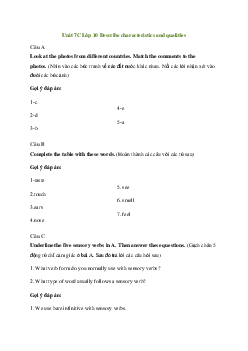


Preview text:
Unit 7D Lớp 10 Compare types of communication Câu A
Does each type of human communication use the sense of sight, hearing, touch or more than
one? (Mỗi loại giao tiếp của con người sử dụng giác quan nhìn, nghe, cảm giác hoặc là nhiều hơn một hay không?) Gợi ý đáp án:
Each type of human communication uses more than one.
(Mỗi kiểu giao tiếp con người sử dụng nhiều hơn một loại.) Tạm dịch
– shaking hands (bắt tay): touch
– writing (viết): sight, touch
– nodding your head (gật đầu): touch
– smiling (mỉm cười): touch
– kissing (hôn): more than one
– laughing (cười lớn): more than one – waving (vẫy tay): touch
– shaking your head (lắc đầu): touch
– yelling (la hét): more than one. Câu B
Match these sentences to actions in A. (Nối các câu với hành động ở bài A) Gợi ý đáp án: 1. shaking your head 2. nooding your head 3. smilling 4. laughing 5. shaking hands 6. waving Câu C
Do any of the example of body language in A have a different meaning in your country? What
are some examples of body language used in your country? (Có ví dụ nào về ngôn ngữ cơ thể ở
A có ý nghĩa khác ở quốc gia của bạn không? Có gì là một số ví dụ về ngôn ngữ cơ thể được sử
dụng ở quốc gia của bạn?) Gợi ý đáp án:
No, there isn’tThere are some examples of body language in Vietnam such as:
Turn slightly head: When paying attention to what you are saying, the opposite person will slightly
turn their head to the side to hear more clearly.
Tilt head: Slightly tilting head indicates that this person is not confident about what was said. Câu D
Read the article. Match the words to the definitions.
(Đọc đoạn văn. Nối các từ với định nghĩa của nó) Gợi ý đáp án: 1-a 4-e 2-d 5-c 3-b Câu E
Are these actions done by humans, elephants or both? Underline supporting information in
the article. (Những hành động sau đây được làm bởi con người, voi hay cả hai? Gạch chân những ý
giúp bạn làm bài trong bài đọc.) Gợi ý đáp án: 1- humans 5- both 2- elephants 6- humans 3- humans 7- both 4- elphants 8- both



